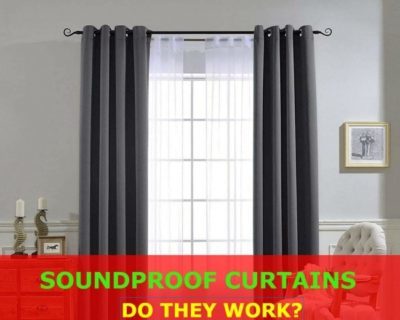Do soundproof curtains really work?
I love quiet places and sitting in silence, so I soundproofed my home office room. Then, I figured out something that I cannot soundproof very well and easy: outside noise. Of course, I can close the windows, but then I won’t get fresh air, and what is the point of living in a house if you can’t keep your windows open. So I searched on Amazon and found soundproof curtains. I did some quick research to find if they actually work, but I couldn’t find much real information at the time.
In this article, I will tell you if they really work, how to choose, and how to install them. It’s pretty easy but you need to consider a few things:
-
-
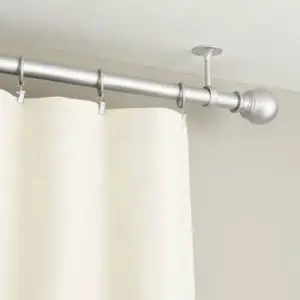
Ceil mount bracket.
This will bring the soundproofing curtain closer to the ceiling. This way, it will absorb more sound. - Choose long curtains – they need to be from ceiling to floor in order to dampen as much noise as possible (usually 96 inches or 244 cm)
- Double the panels you install on each window in order to increase the density. Following this tip, curtains will be able to absorb/dampen more noise.
- Use ceiling brackets – This way, the curtain will cover more space. Using normal wall brackets will be much less effective as a big part of the wall is not covered
-
Curtains are present in most homes, whether in the living room or bedroom. In addition to their obvious aesthetic utility, to embellish a space, curtains also have a secret that many do not know or treat with too much indifference.
Soundproofing curtains facts
This secret is that they can be used to “soundproof” your room. In particular, having soundproof curtains can significantly reduce noise. My house is at about 50 feet from the road. It’s not a busy road, but I do mind the occasional car that revs up the engine or worse, a motorcycle.
Soundproofing curtains are made of layers of materials. Remember what we do when we try to soundproof a room? We create another layer of a fake wall with mineral wool or rock wool in between. The same principle is applied here. Layering materials in a specific order and with high densities prevent noise and sound propagation.
Here is a video explaining how soundproof curtains work and the proper way to use them.
Why use soundproofing curtains?
“Noise severely damages human health and interferes with the activities of everyday people, at school, at work, at home and during leisure time” – The World Health Organization
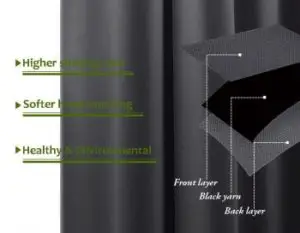
First, the word “soundproof” used here is a bit misleading. Nothing is absolutely soundproof, and neither are the curtains. It’s just the product name. What do we use soundproof curtains for then? Here is what soundproof curtains actually do:
- Act as a barrier between the outside noise and the inside of a room (barrier between source and destination of sound)
- Used for noise above 200Hz. If noise is lower than 200Hz, we need to use something else for soundproofing. Soundproofing curtains will not work in this case.
Sub-bass frequencies are from 20 to 60 Hz.
Bass frequencies are from 60 to 250 Hz.
Only for aesthetic? No!
If you asked me a few weeks ago what the role of drapes and curtains in our lives are, I would have said that their role is rather aesthetic, thinking about how empty it would seem to have a curtain-less house, and how I gave a new breath to the living room by simply inserting decorative pillows and changing the curtains with others matching the pillows.
Okay, I would not have ignored the practical purpose of keeping the inside of our house away from curious eyes, nor the psychological factor (curtains and curtains give us some intimacy). However, I never would have thought that a curtain could give me more peace of mind.
The range of sound absorption from this type of curtains is ideal for soundproofing rooms. Soundproofing curtains are most often used for conference rooms, showrooms, cinemas, theaters, opera rooms, or recording studios. However, curtains of this type also can be used effectively in your home.
Now that I know about soundproof curtains, I can say that soundproof curtains together with chairs work very well in the cinema, absorbing and deadening all the reflected noise.
How I discovered them
I like quiet. I would spend many hours with my thoughts or just reading a book in silence. I hate hearing a car passing by or the dog of a neighbor barking. Not only do I appreciate the peace, but, without it, I cannot concentrate, sleep, or think, I have blockages or I feel angry at the smallest noise.
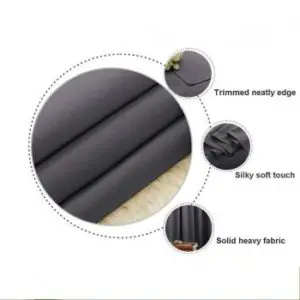
I also do a lot of work in front of the computer, so interruptions are very annoying. Even if I have thick windows, the noise of the noise still finds an entrance gate. It may be the same in your case if you didn’t soundproof your walls.
When I told my problems to my girlfriend, she began to talk about some soundproofing curtains. I did not know exactly what that meant at the time. But, I suspected there must be a curtain that is high-density, thick, and heavy.
With a quick search, I found what she presented to me were sound-absorbing curtains: these are sound-deadening curtains.
In my mind, they would have been more useful to keep the sound out of the room. Then she explained to me that this type of curtains stops much of the noise coming from outside.
Soundproofing curtains usages
Actually, this type of curtains are used especially in places like theaters, concert halls, cinemas, or recording studios, but they also often are being used in homes. The main reason for their value is the fact that they not only look good but are also a good soundproofing method.
That’s when I first heard the soundproofed curtains term. Later on, I read about them on the internet and learned that they are so effective that interior designers around the world rely on them when it comes to decorating houses near airports (I think you can imagine the level of noise pollution in those areas).
How much can soundproof curtains absorb? Will they make a difference?
The sound absorption coefficient is 0.5 – 0.6. In other words, the new material is able to “attenuate” the noise five times more efficiently than conventional transparent curtains (the sound of the room is reduced by 20% compared to the usual 2-3%).
How were soundproof curtains discovered and made?
The idea of creating curtains, which would absorb the excess of sounds while being light and transparent, belongs to textile designer Annette Douglas.
At first, the lighter, optimized acoustic fabric appeared as a computer model. Empa acoustics specialists intended to use the features of this virtual fabric to prepare a “recipe for material specialists that would help them produce fabrics capable of absorbing sounds.”
In addition, they developed a mathematical model to illustrate the microscopic structure of its material and macroscopic composition, based on numerous acoustic indices in various samples (woven by Weisbrod-Zürrer employees).
The researchers were able to gradually improve the acoustic properties of the tissue, then Annette Douglas managed to translate the results studies in the “language” of textile technologies.
The next step was to wonder what made these curtains so special that they could reduce the “amount” of noise entering the house or the echo level in the very large rooms. They are made of flame-retardant polyester, trevira (material that is difficult to ignite) or a combination of the two types of material and are available in a wide range of colors (so if you want to redecorate you can be sure you will find a good shade for your home).
How are the curtains blocking the sound?
They are thick and quite heavy, having a high density. The higher density and weight it has, the better the curtain. Some of the best curtains from this point of view are those on the Amazon.
Be aware that soundproof curtains are not sound blockers. By having an empty space (when the window is open), the sound is transmitted to the room. But, a thick soundproof curtain will reduce the echo of the sound making it sound a lot lower.
Also, it will reduce the vibrations and annoying feeling of loud noise. Imagine your phone ringing in a bathroom. Now imagine it ringing in a full closet. That’s the difference.
By reducing the echo and vibrations, soundproof curtains give a feeling of lower volume. They work really well for me. Now, the cars feel more like background noise than actual noise.
Are they worth it?
I do not say that these soundproofing curtains are enough to have peace of mind if you stay in an intensely circulating area. However, with double-glazed windows, carpeted floor, and sound-absorbing curtains, you surely will sleep quieter, you be able to work and learn more, enjoy the quiet of the weekend mornings, and hear the outside music or the neighbor’s drill a lot less.
So, if you want some simple, decorative curtains, you can buy them anywhere. If you want a beautiful and quiet atmosphere, you should definitely go with soundproofing curtains.
What they will do?
These sound absorbing curtains will reduce the echo in a large room and make the noise seem like background noise. However, curtains do not offer the same level of sound insulation as the soundproofing walls.
The materials from which the curtains are made are blackout, satin, or cotton and are filled with bluff. They are also found in a multitude of color shades and patterns with different prints.
For better soundproofing, the curtains can be doubled or even quilted with the help of the valine, but it can become very heavy and requires a very solid grip. The quilted texture of the drapery prevents the daylight.
Uses for soundproofing drapes
A common use of these soundproofing drapes is in homes or apartments that are located near airports. This ensures a quiet and relaxing sleep. They also can be used in the case of a home theater. Installing them on the walls of that space will help prevent echo and other sounds coming from the outside during movies. Curtains also are used to prevent sound coming back from where it came from. (as known as reverberation)
For maintenance and cleaning of sound-absorbing drapes, it is advisable to call on companies that specialize in such services, as they require increased attention.
How to install them?
Installing soundproofing curtains could not be easier. One of the best things about soundproofing curtains is that you can install them yourself pretty easily.
Here is a basic step by step:
- Get the ceiling brackets, 96 inches or 244 cm curtains and rod if needed from Amazon.
- Install the ceiling brackets – I recommend ceiling installation to block as much sound as possible
- Install the curtain rod
- Hang the new soundproofing curtain – it can be heavy, so be careful
If you already have brackets and the rod installed and don’t want to use ceiling brackets, just go ahead and hang the new curtain.
Other methods?
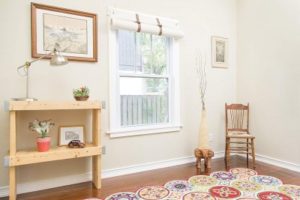
Soundproofing full curtains
If these simple soundproofing curtains are not enough, the next step is to go for full soundproof curtains. These will obviously block more sound by design. Installing soundproofing windows is more difficult and expensive.
You can save some money and use this method as a last resort before going all in for a good soundproof window plus the installation cost.
Conclusion
Sound pollution affects us no less than air or water pollution. First, the noise is annoying. Secondly, it interferes with communication, reduces labor productivity, and makes it tiring until health problems appear.
Usually, in rooms, whether for work, communication, or recreation, noise-absorbing surfaces are used to eliminate noise. Reducing the reflection of sounds creates a relative silence. However, “solid” standard materials used in interior design, such as glass and concrete, cannot handle this function.
We can isolate ourselves from the noisy street with heavy velvet curtains, but the light will also disappear with sounds.
Using a lightweight fabric, transparent from the point of view of acoustic comfort, is completely useless. At least it has been so far.
